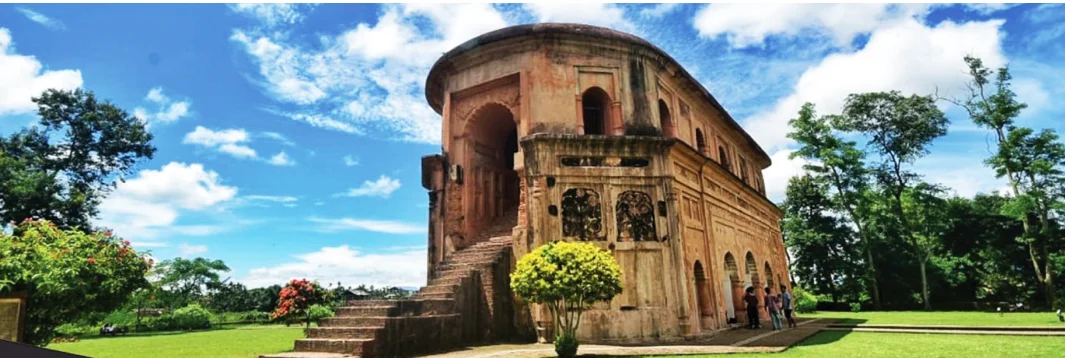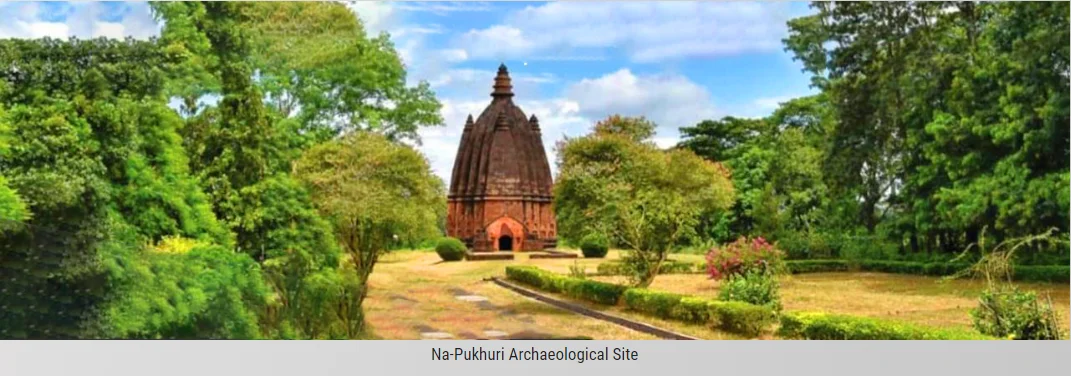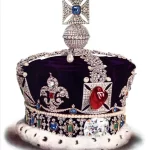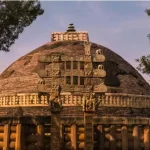Sivasagar is a district in the state of Assam, India, 369 kilometers from Guwahati. The district is located in the upper Brahmaputra valley. It is famous for its historical structures and temples constructed during the period of the Ahom Dynasty.
From the 13th century to the early nineteenth century, the Ahoms dominated Assam’s political and cultural life. Charaideo was one of the first capitals of the Ahom Kingdom.
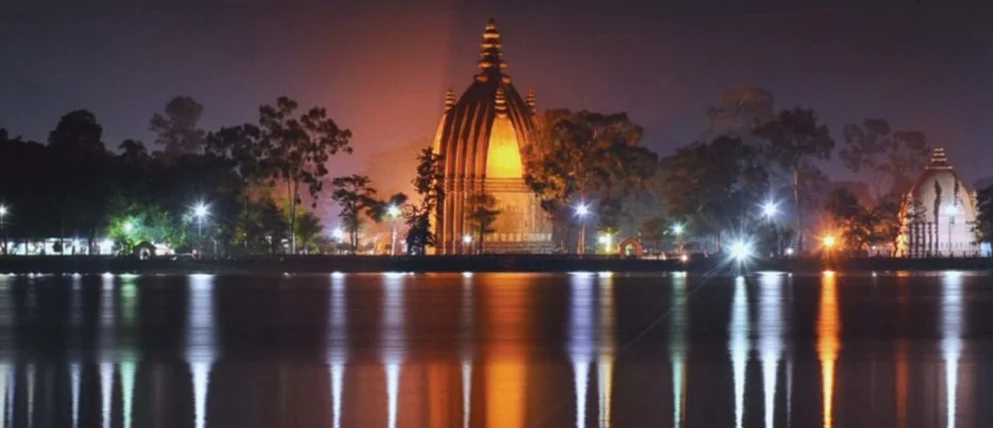
Later, under different monarchs, Saragua, Gargaon, Rangpur, and Jorhat became Ahom Dynasty capitals at various times in time. The Ahoms were descendants of the Shan/Tai tribe of Chinese ancestry, who had settled in Upper Burma.
King Chaolung Sukaphaa, also known as Siu-ka-Pha, later created Sivasagar. Reports state that Siu-ka-pha invaded the Brahmaputra valley in the 13th century with his warriors, elephants, ministers, and bureaucrats, crossing the Patkai Hills.
The Ahom Dynasty’s dominion ended with the Burmese invasion of Assam from 1817 and 1825, followed by the British East India Company’s annexation in 1825.
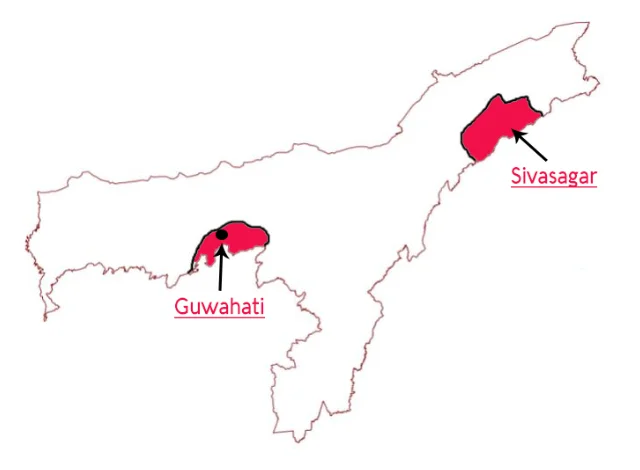
The Ahom dynasty
The Ahom dynasty peaked under the reign of Rudra Simha (1696-1714). During his reign, King Sukaphaa relocated the capital to Meteka, near modern-day Sivasagar. He collaborated with Ghanashyam, the principal architect, to build Rangpur city.
People believe that Ghanasyam was a Muslim from Bengal who eventually converted to Hinduism. As a consequence of Ghanashyam’s influence, we see a fusion of Islamic architectural components such as domes and arches with Hindu elements such as the sikhara.
One can interpret the architecture of structures built under the reign of the Ahoms in two ways: secularly and religiously. Forts, pavilions, and palaces are all examples of secular architecture.
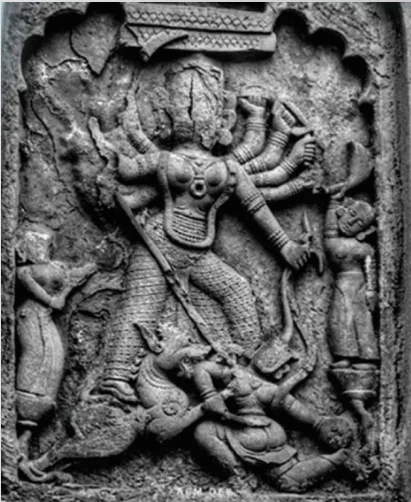
Temples to Lord Siva, Lord Visnu, and Goddess Durga dominate the religious architecture. A almost 600-year-old dynasty prioritized the security of their realm. They built walls at numerous locations, which locals call Garh.
Deep and broad moats named Garkhawoi, which contained water, encircled these structures. Today, people can determine the presence of ramparts by looking for locations with the suffix ‘Garh’ in their names.
People named the city of Sivasagar after the famous Sivasagar tank, also known as Borpukhuri. The city is home to a diverse range of ethnic groups, including Mishing, Naga, Manipuri, Garo, and Deori. The harmonious coexistence of different ethnic groups has resulted in the development of their diverse cultures in Sivasagar.
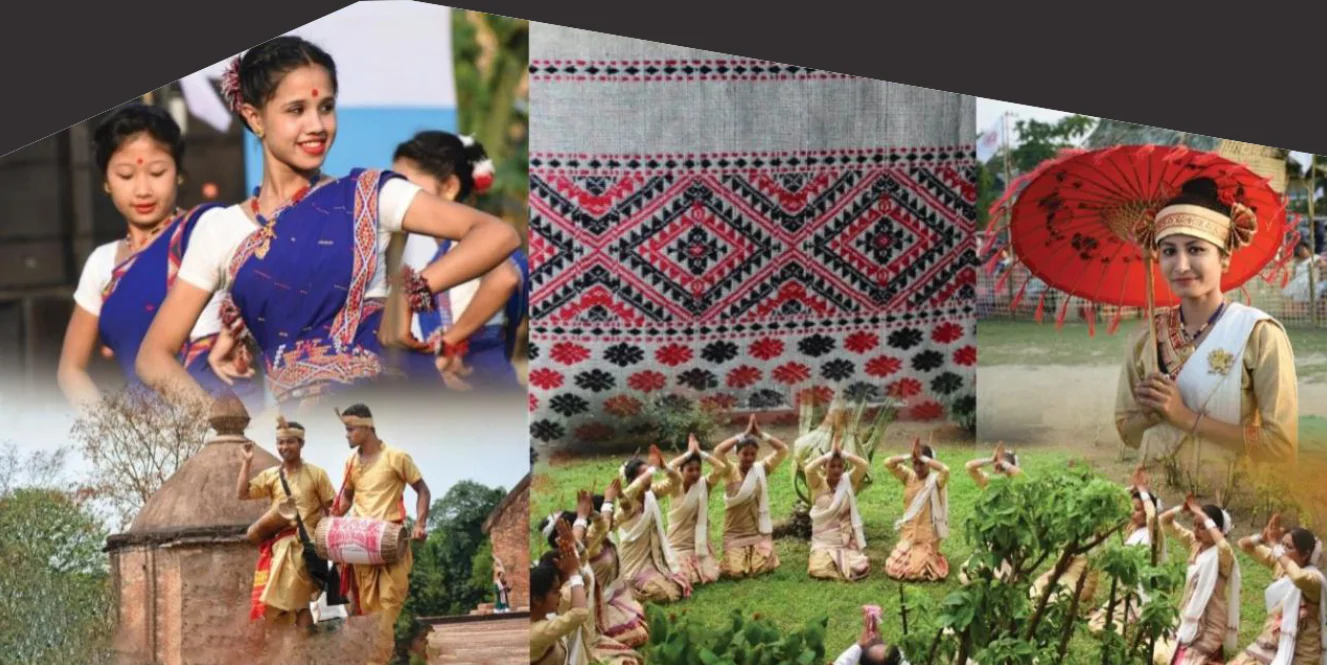
Traditions of Sivasagar Assam
These communities’ art, culture, clothes, dancing, and cuisines are distinct and reflect Assam’s rich past. In contrast, the monuments serve as a representation of the Ahoms’ might and might. Sivasagar residents accepted Hindu ceremonies, beliefs, and practices. Sivasagar is home to two well-known Vaishnavite saints: Mahapurush Srimanta Sankardeva and Sri Sri Madhabdeva.
The Satra of Amguri, Assam, has been transmitting their teachings. Satras are social gathering places affiliated with the Ekaharana Vaishnavism tradition. The word’satra’ appears in the Bhagavata Purana as the Sanskrit term’sattra’, which implies an assembly of devotees.
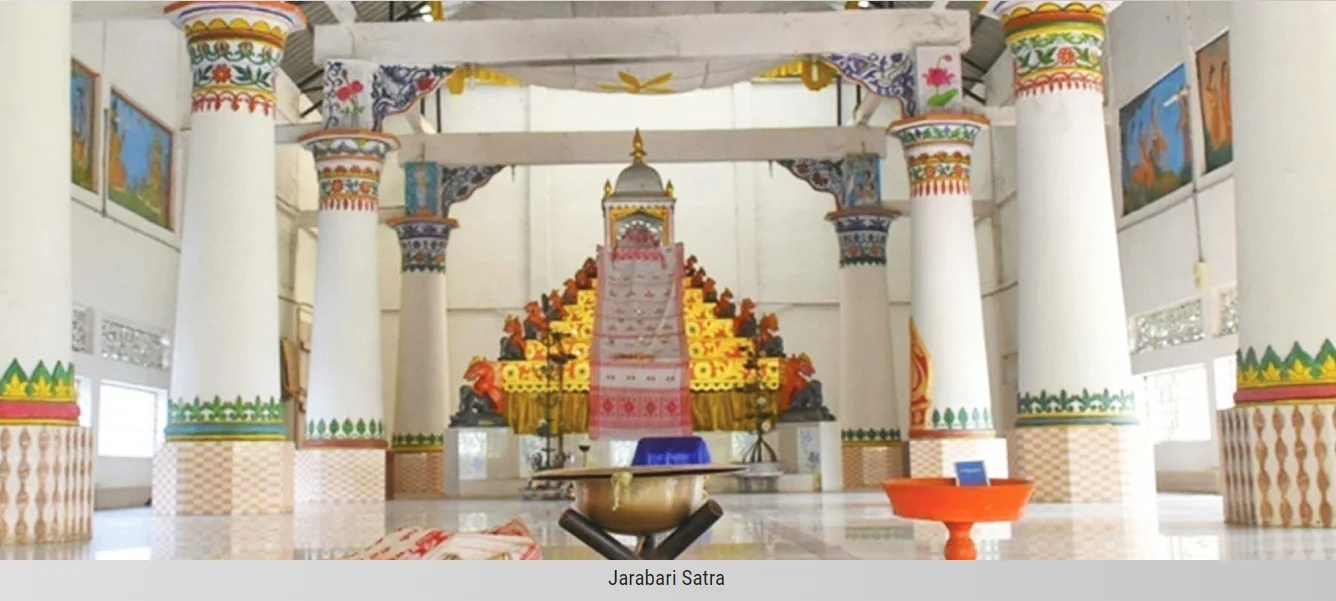 The Ahoms are claimed to have observed three Bihu, or agricultural festivals. Bihu derives from the Tai term ‘Pi-hu’ or ‘Poi-Hu’. The people of Sivasagar observe a variety of traditional festivals and ceremonies, the most important of which is Bihu. The primary festival, Poi-Chankein or Bohang Bihu (held in April), marks the start of the spring season.
The Ahoms are claimed to have observed three Bihu, or agricultural festivals. Bihu derives from the Tai term ‘Pi-hu’ or ‘Poi-Hu’. The people of Sivasagar observe a variety of traditional festivals and ceremonies, the most important of which is Bihu. The primary festival, Poi-Chankein or Bohang Bihu (held in April), marks the start of the spring season.
Festivals 0f Sivasagar
People commemorate it just prior to paddy cultivation. People celebrate this holiday to wish for a bountiful harvest because it is the period when farmers begin sowing.
Chip-song-ka or Kaati Bihu (held in October) commemorates the cutting and binding of grain, whereas Meji Joluwa Utsav or Magh Bihu (observed in January-February) commemorates the agricultural harvesting season.
These three ceremonies primarily focus on ancestor worship, known as Me-Dam-Me-Phi. Whereas Me symbolizes adoration, Dam means the dead, and Phi represents God.
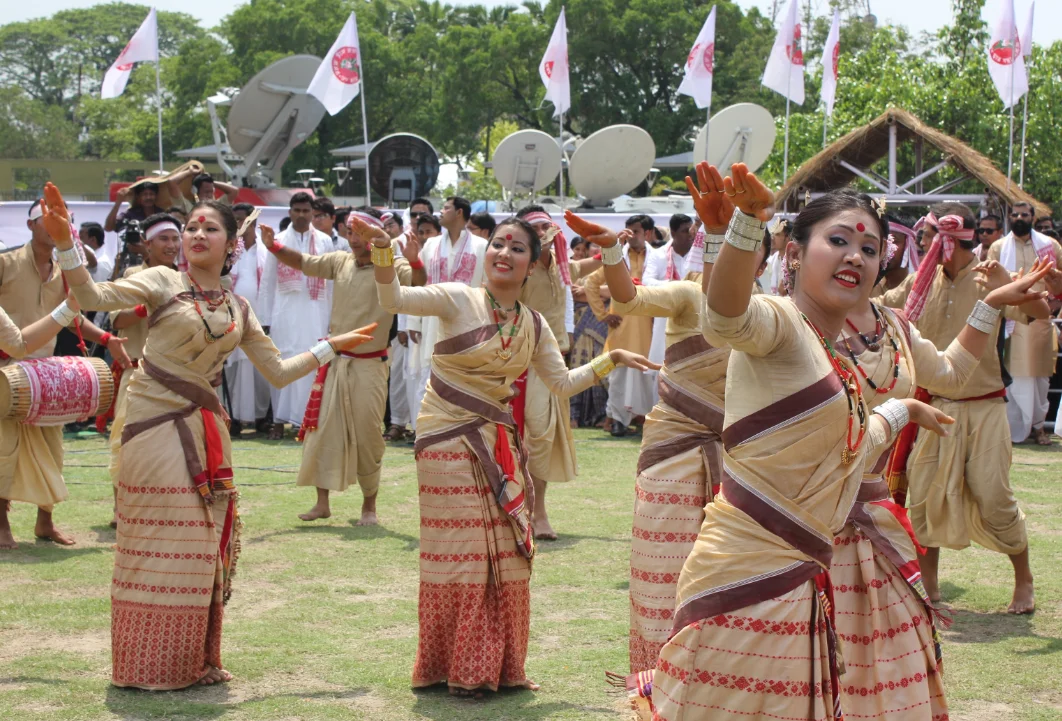
People worship the deceased as gods. People hold Kin-on-Meu, also known as Na-Khuwa, during the new year’s month of Dinsing or Aghun.
During these festivities, people present the first produce of the season to the ancestors. Some traditional traditions practiced during these celebrations include priests singing hymns, eating traditional foods such as Amroli-tup and pig, and drinking lao or rice beer.
The most prominent art forms in Sivasagar are Bihu dance and Bihu Song. People conduct these using the Dhol and Mahar-Singar pepa. Originally, performers sang the Bihu songs in Tai, but they eventually supplanted them with songs in Assamese.
The husari troupe of dancers and singers used to perform Bihu dance for the monarch and nobility in order to bestow riches, good health, and luck.
Period of Ahom King
The Ahom monarchs built several tanks, temples, and historical sites during their reign. The most prominent include water tanks named Sivasagar, Joysagar, and Gaurisagar.
The Ahom monarchs also erected several temples of immense historical significance, including the Sivadol Temple Group. They place these on the bank of Sivasagar Tank, commonly known as Borpukhuri Tank.
The Sivadol building consists of three temples: Sivadol, Vishnudol, and Devidol, devoted to Shiva, the Hindu Lord Vishnu, and the Hindu goddess Durga, respectively.

The Ghanashyam Dol, a terracotta brick temple near Joysagar Tank, is Sivasagar district’s most remarkable temple. According to popular legend, King Rajeswar Singha (1751-1769) built it for his naati (grandson) from the lineage of Parbatiya Gosain.
Hence, the shrine is also known as Naati Gosain Dol. According to another story, Ghanashyam Dol was created under the patronage of King Rudra Singha by Ghanashyam Khanikar, who was brought in as the principal architect to build the city of Rangpur.
Visiting Places
Sivasagar is home to regal pavilions such as “Rang Ghar,” a renowned amphitheater located near Joysagar Tank. Pramatta Singha (1744-1751), the Ahom ruler, created this 18th-century palace. Known as the Colosseum of the East, it was a pavilion where royal families and other dignitaries could watch various games and sports.
Talatal Ghar, an Ahom Army Base, is quite beautifully preserved today. As the biggest Tai monument, it has underground tunnels utilized as escape routes during the Ahom battles.
ALSO READ: Shimla | हिमालय की रानी के शांतिपूर्ण आकर्षणों का अन्वेषण
The two major tunnels are reported to be 16 kilometers and 3 kilometers long. However, these have been closed owing to security concerns.
Ahom kings and queens’ tombstones are referred to as ‘Maidans’. They are built in the shape of pyramids, similar to those seen in Egypt.
The ‘Namdong Stone Bridge’ is a popular construction created from a single solid rock cutting. The magnificent Ajan Peer Dargah Sharif in Sivasagar serves as a symbol of Hindu-Muslim unity. It’s located in Saraguri Chapori.
This hallowed tomb was created in remembrance of Ajan Fakir, a Baghdad-born reformer and saint who arrived in North East India in the 17th century. He was instrumental in uniting the people of the Brahmaputra Valley. This Dargah is visited by a significant number of devotees from all over the world.
Archaeological Site
Aside from its architectural legacy, Sivasagar is home to archeological sites, a zoo, and a sanctuary. One such location is Na-pukhuri Archaeological Site, popularly known as Rudrasagar.
It is situated on the banks of Rudrasagar Tank, a haven for migrating birds. The Shivadol on this location is an architecturally significant edifice. It was erected in 1773 under the reign of King Swaradew Lakshmi Singha. The monument is a classic Ahom construction with an octagonal foundation.
Pohugarh was established as Sivasagar’s first zoo under the leadership of Ahom Swargadeo Rudra Singha. It covers 140 acres and was designed to hold water throughout the year, creating a natural home for animals and birds.
The Assam government created Pani Dihing Wildlife Sanctuary as a bird sanctuary in August 1999. The sanctuary is located between the Brahmaputra and Desang rivers and covers an area of 33.93 square kilometers. The region contains a grassland with over 267 bird species identified, 70 of which are migratory.
The area therefore gives us with a united view of a heterogeneous culture. For many years, it has been a hub of political activity, art, culture, and literature.
